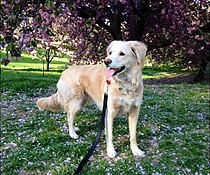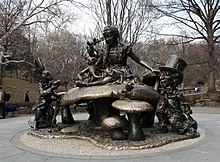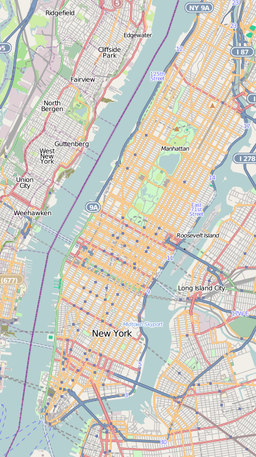| Conservatory Water | |
|---|---|
 Conservatory Water, facing south | |
| Location | Central Park, Manhattan, New York City, New York, USA |
| Coordinates | 40°46′27″N 73°58′03″W / 40.77418°N 73.96747°W |
| Type | pond |
| Website | centralpark.com/conservatory-water |
Conservatory Water is a pond located in a natural hollow within Central Park in Manhattan, New York City. It is located west of Fifth Avenue, centered opposite East 74th Street. The pond is surrounded by several landscaped hills, including Pilgrim Hill dotted by groves of Yoshino cherry trees and Pug Hill, resulting in a somewhat manicured park landscape, planned in deferential reference to the estate plantings of the owners of the mansions that once lined the adjacent stretch of Fifth Avenue.
Conservatory Water is named for a glass-house for tropical plants and was intended to be entered from Fifth Avenue by a grand stair. The shore of Conservatory Water contains the Kerbs Memorial Boathouse, where patrons can rent and navigate radio-controlled model boats, as well as bronze sculptures.
The water was supplied from the Ramble and Lake, the site of the historic Sawkill stream, which once flowed through here on its way to the East River. When Central Park was built in the mid-19th century, hardy water lilies were naturalized in the bottom mud and tender ones were wintered over in the park's conservatory. Later, the naturalistic water lily pond was reshaped as a model boat pond.
History
Conservatory Water is named for another estate-garden feature, a glass-house for tropical plants, to be entered from Fifth Avenue by a grand stair. [1] The garden had been proposed in the Greensward Plan of 1857, during a design competition for Central Park where the Greensward Plan ultimately won out. Several other proposals submitted during the competition did not include a formal garden. The two principal designers of the Greensward Plan, Frederick Law Olmsted and Calvert Vaux, instead suggested building a conservatory on the site of the proposed formal garden, with a "hard-edged" reflecting pool in the middle. Only the reflecting pool was constructed, though. [2]: 146
A naturalistic pond displaying water lilies was excavated. The steep bank towards Fifth Avenue was densely planted with shrubs and trees, including birch—for quick cover—and copper beech. Samuel Parsons, Calvert Vaux's assistant and partner, who was named Superintendent of Plantings, described the effect in his Landscape Gardening (1891):
The general shape of this pond was oval, with winding, irregular shores, bounded by a high bank on the east side and a great willow drooping over the north end. Rocks were disposed in the immediate banks, so as to suggest a natural formation, rather than an artificial pond. The bottom, scarcely three feet deep, was cemented tight as a cup, and the water flowed gently in at one end, and out at the other, and so through a basin and into the sewer. Eighteen inches of soil was made rich with manure and deposited over the bottom. [3]
The water was supplied from the Ramble and Lake, the site of the historic Sawkill stream, which once flowed through here on its way to the East River. [4] Hardy water lilies, both European and American, were naturalized in the bottom mud and tender ones, planted in boxes, were wintered over in the park's conservatory, now the site of Conservatory Garden.

Since the 1860s, children had sailed their model yachts at the pond. [5] Later, the naturalistic water lily pond was reshaped as a model boat pond loosely based on that of one in the Jardin du Luxembourg, in Paris. [6] [7]
The formally shaped shallow basin is set in a molded curb of "Atlantic Blue" granite, which replaced a concrete curb in 2000. [8] [9] It is home water to a flotilla of model sailboats. [2]: 146 [5]
The model sailboats were made familiar in the pages of E.B. White's children's realistic fantasy novel Stuart Little (1945) about a mouse-like human boy who sailed his ship on Conservatory Water. [2] [5] The novel was recreated in the popular family animated/live-action comedy 1999 film of the same name. [2]: 146 [5]
Boathouse

The eastern shore of Conservatory Water contains the Kerbs Memorial Boathouse, designed by architect Aymar Embury II, where patrons can rent and navigate radio-controlled and wind-powered model boats. [10] [6] [11] [12] The 1954 boathouse, in picnic Georgian taste with red brick and a green copper hip roof and steeple, outside of which is a flagstone patio, [13] [14] houses resident model sailboats as well as the radio-controlled model yachts of the Central Park Model Yacht Club.
Surroundings
The waters of Conservatory Water shelter a seasonal population of unusual minute freshwater jellyfish, Craspedacusta sowerbyi. In the sculptured Beaux-Arts pediment of an upper-floor window of 927 Fifth Avenue, overlooking Conservatory Water, the red-tailed hawk named " Pale Male" set up a nest, under the binocular watch of the Park's numerous bird-watchers.
Pilgrim Hill

Pilgrim Hill lies to the southwest of Conservatory Water, just inside the park entrance at 5th Avenue and on the north side of 72nd Street. [15] [16] [17] [18] Its slopes are popular among locals for sledding in the winter when Central Park receives 6 inches of snow, for groves of pale flowering Yoshino cherry trees as they burst into bloom in the spring, and for picnics and lounging in warmer months. [16] [17] The slopes are dotted by Prunus serrulata and other specimen trees, notably a globose European Hornbeam and nine species of oak, all set in rolling lawn.
They are surveyed by artist John Quincy Adams Ward's bronze statue of The Pilgrim, a 9 feet (2.7 m) tall stylized representation of one of the Pilgrims, British immigrants to the New World led by William Bradford who left from Plymouth, England, in the cargo ship Mayflower in September 1620. [18] [19] The statue faces westward on the crest of a little knoll at the top of the hill, on a rusticated Quincy granite pedestal that was created by architect Richard Morris Hunt and contains four bas-reliefs (depicting the ship the Mayflower, Bible and Sword, Cross-Bow and Arrows, and Commerce), overlooking the East Drive at East 72nd Street. [19] [16] [17] [20] The statue was donated to New York City in 1885 by the New England Society of New York. [16] [17] [18] [5]
Pug Hill
Pug Hill is located to the northwest of the Alice and Wonderland statue and was a popular place for the city's pug owners to socialize in the late 1990s through the mid-2000s. [21] At times, there were so many pugs present that they were described as a fawn and black whirlpool moving through the grass. [22] However, Pug Hill gatherings were ended due to heavy NYC Parks enforcement. [23] In 2006, Pug Hill was the inspiration for an eponymous book. [24]
Alice in Wonderland sculpture

Bronze sculptural groups set in small terraces front the Conservatory Water. One to the north, parallel with East 74th Street, commemorates Lewis Carroll's 1865 novel Alice in Wonderland, with an 11 feet (3.4 m) tall Alice (whose face is modeled on that of the sculptor's daughter) sitting on a large mushroom at a tea party held by the Mad Hatter (whose face is supposedly modeled on that of George Delacorte) with the March Hare, the White Rabbit, the Dormouse, the Cheshire Cat, the Caterpillar, and Alice's kitten Dinah in her lap. [25] [26] [27] [28] It was created in 1959 by sculptor José de Creeft, patterned on illustrations drawn by John Tenniel, commissioned by philanthropist George Delacorte in honor of his wife, and forged in the Modern Art Foundry in Queens, New York. [26] [28] It is favored by children who enjoy climbing on it, which was contemplated in its design. [26] At the base of the statue, among other inscriptions, is a line from Lewis Carroll's 1871 nonsense poem " Jabberwocky". [29]
Hans Christian Andersen sculpture
Another sculptural group, to the west of the Conservatory Water, commemorates Danish fable author Hans Christian Andersen and the Ugly Duckling (1955), sculpted by Georg John Lober. [30] [31] [32] [33] [34] [35] A larger-than-life-size 9 feet 6 inches (2.90 m) Anderson sits on a Stony Creek polished pink granite bench with an open book on his lap, turned to the story of "The Ugly Duckling," with a 2 feet (0.61 m)-tall bronze duck at his feet. [36] [37] [38] [31] [28] In the palm of Andersen's left hand, the sculptor inscribed: "In appreciation of the help and encouragement my wife Nellie has always given me affectionately, Georg, 1956." [39] The statue is meant to be climbed on. [40] The sculpture was cast in the Modern Art Foundry. [36]
These sculptures were built by NYC Parks commissioner Robert Moses in the 1950s as part of the park's "Children's District". Another statue, that of the fictional Mary Poppins, was not constructed. [2]: 146
Waldo Hutchins bench
Discreetly sited overlooking Conservatory Water, just inside Central Park north-west of the park's East 72nd Street and Fifth Avenue entrance, and east of Pilgrim Hill, is a curved Concord white granite exedra (a design from ancient Greece and Rome) outdoor bench. [28] [41] [42] [43] [44] [45] [46] It commemorates Waldo Hutchins (1822–1891), a member of the original Board of Commissioners for Central Park, New York City Park Commissioner (1857–1869 and 1887–1891), and a three-term Representative to the U.S. Congress (1879–1885). [45] [46] [47]
The bench is almost 4 feet (1.2 m) tall by 27 feet (8.2 m) long, and weighs several tons. [46] [48] The cost of the bench was $15,000 ($330,000 in current dollar terms). [49] Its architect was Eric Gugler, and in 1932 it was executed by the Piccirilli Brothers studio, the firm that carved the Lincoln Memorial in Washington, D.C. [46]
The bench has a small sundial, a variation on a 3rd century BC Hellenistic period Berossus sundial, at its back designed by sculptor Albert Stewart. [50] [48] [49] [46] [47] The sundial features a small Art Deco bronze gnomon sculpture of a female dancer trailed by a wind-blown gown and flowing scarves at its center. [50] [48] [49] [46] [47] The gnomon sculpture was crafted by sculptor Paul Manship, who created the 18-foot (5.5 m)-tall bronze gilded Prometheus statue at Rockefeller Center. [50] [48] [49] [51] [46] [47]
Incised in the bench and paving three semicircular arced lines match the bench shelf’s shadow lines at 10:00 a.m., noon, and 2:00 p.m. at the vernal and autumnal equinoxes--though today daylight saving time has thrown the times off by one hour in the spring. [52] [45] [46] There are two Latin inscriptions etched into the back of the bench: vivas oportet si vis tibi vivere ("One must live for another, if he wishes to live for himself"; a quotation of the Roman philosopher Seneca the Younger); and the sundial reads ne diruatur fuga temporum ("Let it not be destroyed by the passage of time"). [44] [47] If two people sit at opposite ends of the bench and speak softly into it, they can hear each other easily. [45] On the backside to the west, Pilgrim Hill overlooks the bench and Conservatory Water. [16]
References
- ^ Rogers, Elizabeth (1987). Rebuilding Central Park: a management and restoration plan. Cambridge, Mass: MIT Press. p. 124. ISBN 978-0-262-18127-3. OCLC 14586688.
- ^ a b c d e Miller, Sara (2003). Central Park: an American masterpiece. New York: Harry N. Abrams Publishers in association with the Central Park Conservancy. ISBN 978-0-8109-3946-2. OCLC 50773395.
- ^ Parsons, Samuel (2017) [1891]. Landscape Gardening: Notes and Suggestions on Lawns and Lawn Planting--laying Out and Arrangement of Country Places, Large and Small Parks, Cemetery Plots, and Railway-station Lawns--deciduous and Evergreen Trees and Shrubs--the Hardy Border-bedding. Hansebooks. p. 251. ISBN 978-3-337-22434-9. Retrieved August 16, 2020.
- ^ G. E. Hill and G. E. Waring Jr, "Old wells and watercourses on the isle of Manhattan, part I" in M. W. Goodwin et al., eds., 1897. Historic New York: Being the First Series of the Half Moon Papers, quoted in Sanderson, Eric (2013). Mannahatta: a natural history of New York City. New York London: Abrams. p. 254. ISBN 978-1-61312-573-1. OCLC 897840866.
- ^ a b c d e Miller, Sara Cedar (2020). Seeing Central Park: The Official Guide Updated and Expanded. Abrams. ISBN 978-1-68335-879-4.
- ^ a b Sergey Kadinsky (2016). Hidden Waters of New York City: A History and Guide to 101 Forgotten Lakes, Ponds, Creeks, and Streams in the Five Boroughs
- ^ Dorling Kindersley (2012). Eyewitness Travel Family Guide New York City
- ^ "CENTRAL PARK: 150 YEARS OF PARK HISTORY". Taxi Limousine Coach Magazine. June 2006.
- ^ "CPC History: 1998-2002". centralparknyc.org. October 11, 2006. Archived from the original on October 11, 2006. Retrieved August 16, 2020.
- ^ Stern, Robert A. M.; Mellins, Thomas; Fishman, David (1995). New York 1960: Architecture and Urbanism Between the Second World War and the Bicentennial. New York: Monacelli Press. p. 764. ISBN 1-885254-02-4. OCLC 32159240. OL 1130718M.
- ^ "Conservatory Water". The Official Website of Central Park NYC. Central Park Conservancy. Archived from the original on April 16, 2019. Retrieved April 16, 2019.
- ^ "Jeanne E. Kerbs: NYC Parks". Central Park Monuments. June 26, 1939. Retrieved April 16, 2019.
- ^ "Kerbs Boathouse". Central Park Conservancy. November 5, 2018.
- ^ Berenson, Richard L. (1999). Barnes & Noble Complete Illustrated Map and Guidebook to Central Park. Produced for Silver Lining Books by Berenson Design & Books. p. 55. ISBN 978-0-7607-1660-1. OCLC 54885164.
- ^ General Society of Mayflower Descendants (2005). The Mayflower Quarterly. The Mayflower Quarterly. Vol. 71. General Society of Mayflower Descendants. Retrieved August 16, 2020.
- ^ a b c d e "Pilgrim Hill". www.centralpark.com. April 3, 2019. Retrieved August 16, 2020.
- ^ a b c d "Pilgrim Hill". Central Park Conservancy. July 28, 2020. Retrieved August 16, 2020.
- ^ a b c Walsh, Kevin (January 8, 2020). "PILGRIM HILL, Central Park". Forgotten New York. Retrieved August 16, 2020.
- ^ a b "Pilgrim: NYC Parks". Central Park Monuments. June 26, 1939. Retrieved August 16, 2020.
- ^ Carroll, R.; Berenson, R.J. (2008). The Complete Illustrated Map and Guidebook to Central Park. Sterling Publishing Company, Incorporated. p. 57. ISBN 978-1-4027-5833-1. Retrieved August 16, 2020.
- ^ Yazigi, Monique P. (June 1, 1997). "While the Pugs Eat the Caviar, Owners Bond". The New York Times. ISSN 0362-4331. Retrieved April 26, 2017.
- ^ Ethan Brown (May 29, 2000). "Pets: Every Dog Has Its Day". New York Magazine. Retrieved April 26, 2017.
- ^ Smerd, Jeremy (May 7, 2006). "When the Smoking Gun Looks a Lot Like a Leash". The New York Times. ISSN 0362-4331. Retrieved April 26, 2017.
- ^ Pace, Alison (2006). Pug Hill. New York, NY: Penguin. ISBN 0425209717.
- ^ Meier, Allison (February 15, 2016). "The Unsung Female Muses of New York's Public Sculpture". Hyperallergic.
- ^ a b c "Alice in Wonderland Statue in Central Park". Atlas Obscura.
- ^ Howard Halle (March 20, 2020). "10 great outdoor sculptures in NYC you can visit on a socially-distanced stroll". Time Out New York.
- ^ a b c d Carroll, Raymond (May 20, 2008). The Complete Illustrated Map and Guidebook to Central Park. Sterling Publishing Company, Inc. ISBN 9781402758331 – via Google Books.
- ^ Rebecca Fishbein (April 16, 2015). "The 16 Best Public Art Pieces In NYC". Gothamist.
- ^ "'Most Unusual and Surrealistic' Central Park « Ted Landphair's America".
- ^ a b Elizabeth Barlow Rogers (2018). Saving Central Park; A History and a Memoir
- ^ "Alice in Wonderland - Central Park Conservancy & Gardens". centralpark.org.
- ^ "Alice in Wonderland". www.centralpark.com. April 12, 2019.
- ^ "Alice in Wonderland". Central Park Conservancy. January 28, 2019.
- ^ New York. Blue guide. E. Benn. 1983. Retrieved August 17, 2020.
- ^ a b "Central Park Monuments - Hans Christian Andersen : NYC Parks". www.nycgovparks.org.
- ^ Tattoli, Chantel. "Landmark Princess". Los Angeles Review of Books.
- ^ Lee, Patty. "The 16 Best Things to Do in Central Park". Thrillist.
- ^ "Hans Christian Andersen". Central Park Conservancy. January 28, 2019.
- ^ "Hans Christian Andersen". www.centralpark.com. January 11, 2018.
- ^ Henry Hope Reed, Sophia Duckworth (1972). Central Park; a History and a Guide
- ^ Andrea Kannapell (1999). The Curious New Yorker; 329 Fascinating Questions and Surprising Answers about New York City.
- ^ Natalie Zaman (2016). Magical Destinations of the Northeast; Sacred Sites, Occult Oddities & Magical Monuments
- ^ a b Elizabeth Macaulay-Lewis, Matthew McGowan (2018). Classical New York; Discovering Greece and Rome in Gotham.
- ^ a b c d "Waldo Hutchins Memorial Bench|Piccirilli Brothers|Whispering Bench". centralparkinbronze. Archived from the original on May 29, 2023. Retrieved August 20, 2020.
- ^ a b c d e f g h "Central Park Monuments - Waldo Hutchins: NYC Parks". www.nycgovparks.org.
- ^ a b c d e "Waldo Hutchins Bench". Central Park Conservancy. February 1, 2019.
- ^ a b c d Waldo Hutchins Bench Sundial, New York, USA, October 6, 2016.
- ^ a b c d Miller, Tom (October 25, 2018). "Daytonian in Manhattan: The Waldo M. Hutchins Bench - Central Park".
- ^ a b c Morrow, Susan Brind (2006). Wolves and Honey: A Hidden History of the Natural World. Houghton Mifflin Harcourt. ISBN 0618619208 – via Google Books.
- ^ István Hargittai, Magdolna Hargittai (2017). New York Scientific; A Culture of Inquiry, Knowledge, and Learning
- ^ "NASS". sundials.org.
External links
- 1854 establishments in New York (state)
- 1885 sculptures
- 1932 sculptures
- 1955 sculptures
- 1959 sculptures
- Alice's Adventures in Wonderland
- Boathouses in the United States
- Bronze sculptures in Central Park
- Calvert Vaux designs
- Central Park
- Cultural depictions of Hans Christian Andersen
- Frederick Law Olmsted works
- Lakes of Manhattan
- Lakes of New York (state)
- Monuments and memorials in Manhattan
- Sculptures in Central Park
- Statues in New York City



